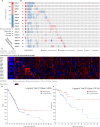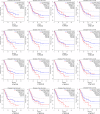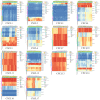Prognostic Biomarkers and Immunotherapeutic Targets Among CXC Chemokines in Pancreatic Adenocarcinoma
- PMID: 34497764
- PMCID: PMC8419473
- DOI: 10.3389/fonc.2021.711402
Prognostic Biomarkers and Immunotherapeutic Targets Among CXC Chemokines in Pancreatic Adenocarcinoma
Abstract
Background: Pancreatic cancer is one of the principal causes of tumor-related death worldwide. CXC chemokines, a subfamily of functional chemotactic peptides, affect the initiation of tumor cells and clinical outcomes in several human malignant tumors. However, the specific biological functions and clinical significance of CXC chemokines in pancreatic cancer have not been clarified.
Methods: Bioinformatics analysis tools and databases, including ONCOMINE, GEPIA2, the Human Protein Atlas, DAVID, GeneMANIA, cBioPortal, STRING, DGidb, MethSurv, TRRUST, SurvExpress, SurvivalMeth, and TIMER, were utilized to clarify the clinical significance and biological functions of CXC chemokine in pancreatic cancer.
Results: Except for CXCL11/12, the transcriptional levels of other CXC chemokines in PAAD tissues were significantly elevated, and the expression level of CXCL16 was the highest among these CXC chemokines. Our findings also suggested that all of the CXC chemokines were linked to tumor-immune dysfunction involving the abundance of immune cell infiltration, and the Cox proportional hazard model confirmed that dendritic and CXCL3/5/7/8/11/17 were significantly associated with the clinical outcome of PAAD patients. Furthermore, increasing expressions of CXCL5/9/10/11/17 were related to unfavorable overall survival (OS), and only CXCL17 was a prognostic factor for disease-free survival (DFS) in PAAD patients. The expression pattern and prognostic power of CXC chemokines were further validated in the independent GSE62452 dataset. For the prognostic value of single CpG of DNA methylation of CXC chemokines in patients with PAAD, we identified 3 CpGs of CXCL1, 2 CpGs of CXCL2, 2 CpGs of CXCL3, 3 CpGs of CXCL4, 10 CpGs of CXCL5, 1 CpG of CXCL6, 1 CpG of CXCL7, 3 CpGs of CXCL12, 3 CpGs of CXCL14, and 5 CpGs of CXCL17 that were significantly associated with prognosis in PAAD patients. Moreover, the prognostic value of CXC chemokine signature in PAAD was explored and tested in two independent cohort, and results indicated that the patients in the low-risk group had a better OS compared with the high-risk group. Survival analysis of the DNA methylation of CXC chemokine signature demonstrated that PAAD patients in the high-risk group had longer survival times.
Conclusions: These findings reveal the novel insights into CXC chemokine expression and their biological functions in the pancreatic cancers, which might serve as accurate prognostic biomarkers and suitable immunotherapeutic targets for patients with pancreatic cancer.
Keywords: CXC chemokines; bioinformatics; immunotherapeutic targets; pancreatic cancer; prognostic biomarkers.
Copyright © 2021 Huang, Chen, Ding, Lin, Wan and Ren.
Conflict of interest statement
The authors declare that the research was conducted in the absence of any commercial or financial relationships that could be construed as a potential conflict of interest.
Figures













Similar articles
-
Identification of therapeutic targets and prognostic biomarkers among CXC chemokines in hepatocellular carcinoma microenvironment.Cancer Biomark. 2023;36(3):231-250. doi: 10.3233/CBM-210300. Cancer Biomark. 2023. PMID: 36938723
-
CC Chemokine Receptors in Lung Adenocarcinoma: The Inflammation-Related Prognostic Biomarkers and Immunotherapeutic Targets.J Inflamm Res. 2021 Feb 5;14:267-285. doi: 10.2147/JIR.S278395. eCollection 2021. J Inflamm Res. 2021. PMID: 33574689 Free PMC article.
-
Exploration of prognostic biomarkers and therapeutic targets in the microenvironment of bladder cancer based on CXC chemokines.Math Biosci Eng. 2021 Jul 19;18(5):6262-6287. doi: 10.3934/mbe.2021313. Math Biosci Eng. 2021. PMID: 34517533
-
The Effect of Hypoxia on the Expression of CXC Chemokines and CXC Chemokine Receptors-A Review of Literature.Int J Mol Sci. 2021 Jan 15;22(2):843. doi: 10.3390/ijms22020843. Int J Mol Sci. 2021. PMID: 33467722 Free PMC article. Review.
-
Identify potential prognostic indicators and tumor-infiltrating immune cells in pancreatic adenocarcinoma.Biosci Rep. 2022 Feb 25;42(2):BSR20212523. doi: 10.1042/BSR20212523. Biosci Rep. 2022. PMID: 35083488 Free PMC article. Review.
Cited by
-
Exploring the role of CD8+ T cells in clear renal cell carcinoma metastasis.FEBS Open Bio. 2024 Jul;14(7):1205-1217. doi: 10.1002/2211-5463.13819. Epub 2024 Jun 13. FEBS Open Bio. 2024. PMID: 38872260 Free PMC article.
-
High Expression of EZH2 Mediated by ncRNAs Correlates with Poor Prognosis and Tumor Immune Infiltration of Hepatocellular Carcinoma.Genes (Basel). 2022 May 13;13(5):876. doi: 10.3390/genes13050876. Genes (Basel). 2022. PMID: 35627262 Free PMC article.
-
Exploring the Potential of Pyroptosis-Related Genes in Predicting Prognosis and Immunological Characteristics of Pancreatic Cancer From the Perspective of Genome and Transcriptome.Front Oncol. 2022 Jun 16;12:932786. doi: 10.3389/fonc.2022.932786. eCollection 2022. Front Oncol. 2022. PMID: 35785176 Free PMC article.
-
Leucine rich repeat LGI family member 3: Integrative analyses support its prognostic association with pancreatic adenocarcinoma.Medicine (Baltimore). 2024 Feb 23;103(8):e37183. doi: 10.1097/MD.0000000000037183. Medicine (Baltimore). 2024. PMID: 38394487 Free PMC article.
-
A novel 7-chemokine-genes predictive signature for prognosis and therapeutic response in renal clear cell carcinoma.Front Pharmacol. 2023 Mar 20;14:1120562. doi: 10.3389/fphar.2023.1120562. eCollection 2023. Front Pharmacol. 2023. PMID: 37021054 Free PMC article.
References
LinkOut - more resources
Full Text Sources
Miscellaneous

